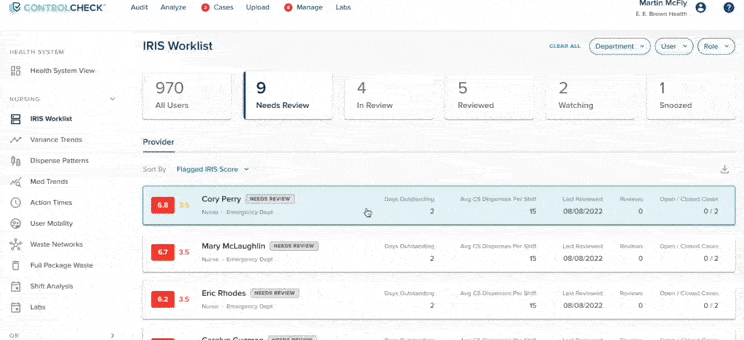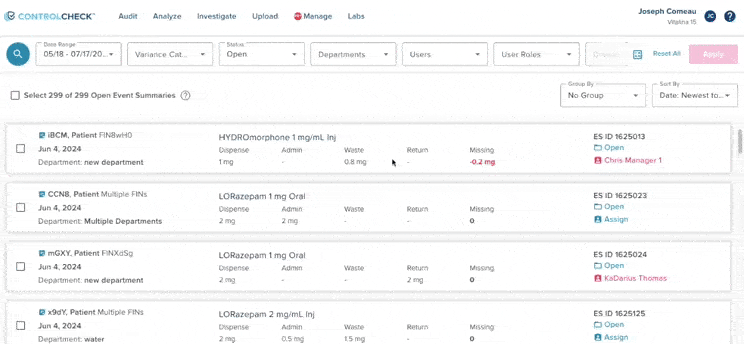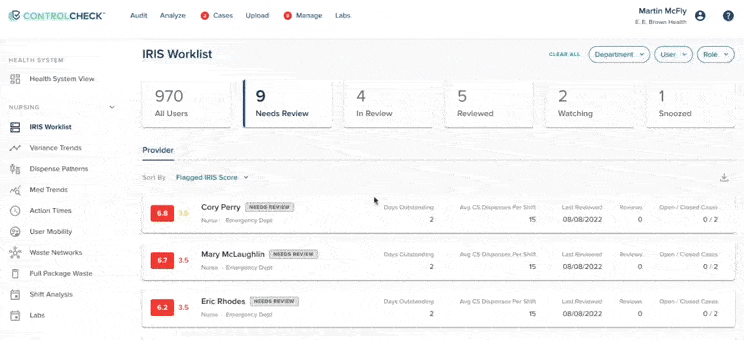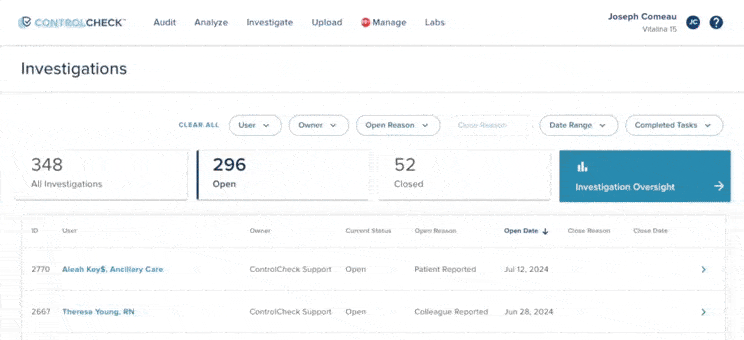
Drug Diversion Surveillance Software
ControlCheck is the most comprehensive and collaborative drug diversion monitoring software on the market. It’s a 4x Best-in-KLAS winner and is trusted by the nation’s top health systems because it detects drug diversion 6.6x more effectively than other next-generation solutions and delivers unmatched clinical support for programs.
ControlCheck provides an end-to-end monitoring, surveillance, and detection workflow that both confirms and prevents drug diversion across nursing, OR, inpatient pharmacy, and retail pharmacy operations. Its easy-to-use drug diversion platform automates closed-loop transaction reconciliation and provides guided workflows, making it super simple for your teams to stay on top of things.
It is consistently being updated with new features every two weeks and stands out as the only solution to address controlled substance diversion monitoring across inpatient, ambulatory, and retail settings.
The State of Drug Diversion Today
Successful drug diversion detection monitoring programs rely on coordinated efforts, robust compliance processes, vigilant oversight, and unwavering patient safety safeguards.
The Solution: End-to-End Drug Diversion Software
Leverage a Comprehensive Approach
Build a reliable drug diversion program and avoid gaps in your diversion surveillance with both collaborative workflows and visibility across various settings. As the most nurse-friendly drug diversion monitoring software, ControlCheck enables interdisciplinary collaboration and offers unlimited user seats. The Nursing, OR, and Pharmacy Modules synthesize data from your ADCs, EHR, wholesaler, controlled substance vault, and time and attendance reports to automatically reconcile 95% of transactions – allowing your teams to better prioritize their time. Additionally, health systems can benchmark their drug diversion program metrics against others in the industry, and participate in the Diversion Collective to build and improve their diversion monitoring strategy.

Be Prepared for DEA Audits
Stay compliant with diligent documentation of all medication transactions. ControlCheck conducts closed-loop dose reconciliation by tracing each dispense through corresponding administration, waste, or return and makes sure the full amount is accounted for. After ControlCheck automatically reconciles most transactions, your team can examine the remaining discrepancies, track each resolution for a complete audit trail, and search for a specific record at any time.

Identify High-Risk Behavior
Proactively identify behavior abnormalities to keep your patients and hospital safe. ControlCheck’s proprietary Individual Risk Identification Score (IRIS) monitors staff behavior – based on demographics and data from reports such as Waste Networks, Dispense Trends, Shift Analysis and more – and compares individuals based on hospital, care area, and department. The IRIS Worklist prioritizes scores so you can focus your reviews where drug diversion is most likely to happen.

Investigate and Confirm Diversion
When drug diversion is suspected, dig deeper to verify whether or not diversion occurred. After opening an investigation and referencing your customized investigation checklist, use the centralized evidence collection functionalities to confirm drug diversion or close the case in a timely manner. Add notes and attachments, link specific transactions, reference observed behavior reports, and collaborate with your multidisciplinary diversion team in-app.

Combat Diversion In Retail Pharmacies
ControlCheck continues to be the most comprehensive diversion monitoring software on the market – now adding a Retail Pharmacy module to solve for the gaps existing in retail and outpatient pharmacy diversion monitoring today. This new retail module allows health systems to view all retail pharmacy activity in a single view to easily identify, audit, and reconcile unusual activity across controlled substances ordered and received.
Leverage a Comprehensive Approach
Build a reliable drug diversion program and avoid gaps in your diversion surveillance with both collaborative workflows and visibility across various settings. As the most nurse-friendly drug diversion monitoring software, ControlCheck enables interdisciplinary collaboration and offers unlimited user seats. The Nursing, OR, and Pharmacy Modules synthesize data from your ADCs, EHR, wholesaler, controlled substance vault, and time and attendance reports to automatically reconcile 95% of transactions – allowing your teams to better prioritize their time. Additionally, health systems can benchmark their drug diversion program metrics against others in the industry, and participate in the Diversion Collective to build and improve their diversion monitoring strategy.

Be Prepared for DEA Audits
Stay compliant with diligent documentation of all medication transactions. ControlCheck conducts closed-loop dose reconciliation by tracing each dispense through corresponding administration, waste, or return and makes sure the full amount is accounted for. After ControlCheck automatically reconciles most transactions, your team can examine the remaining discrepancies, track each resolution for a complete audit trail, and search for a specific record at any time.

Identify High-Risk Behavior
Proactively identify behavior abnormalities to keep your patients and hospital safe. ControlCheck’s proprietary Individual Risk Identification Score (IRIS) monitors staff behavior – based on demographics and data from reports such as Waste Networks, Dispense Trends, Shift Analysis and more – and compares individuals based on hospital, care area, and department. The IRIS Worklist prioritizes scores so you can focus your reviews where drug diversion is most likely to happen.

Investigate and Confirm Diversion
When drug diversion is suspected, dig deeper to verify whether or not diversion occurred. After opening an investigation and referencing your customized investigation checklist, use the centralized evidence collection functionalities to confirm drug diversion or close the case in a timely manner. Add notes and attachments, link specific transactions, reference observed behavior reports, and collaborate with your multidisciplinary diversion team in-app.

Combat Diversion In Retail Pharmacies
ControlCheck continues to be the most comprehensive diversion monitoring software on the market – now adding a Retail Pharmacy module to solve for the gaps existing in retail and outpatient pharmacy diversion monitoring today. This new retail module allows health systems to view all retail pharmacy activity in a single view to easily identify, audit, and reconcile unusual activity across controlled substances ordered and received.
1,200+
cases of diversion confirmed
29,300
potential diversion cases investigated and closed
15.6M+
discrepant medication transactions identified
95%
auto-close rate for medication transaction audits

SUCCESS STORY
University of California, San Francisco Health
Complying with California’s strict reconciliation requirement was a time-consuming process that added additional stress to their leadership teams’ day-to-day responsibilities. ControlCheck was able to auto-reconcile 95% of their controlled substance vault transactions and decrease the amount of time it took by 74%.
ControlCheck™ Brochure
Diversion events put your staff, patients, and the reputation of your hospital at risk….
Learn MoreWhat Our Customers Have to Say
“The diversion software uncovered notable activity on Day 1 of implementation. The software alerted us to a case of a missing dispense with the administration already charted. Without the diversion software, this discrepancy would likely not have been caught promptly.”
Brianna Graham, MSN, RN, NPD-BC, ONC Diversion Prevention Specialist
Want to learn more about ControlCheck?
Request a demo to see ControlCheck in action and discover how Bluesight can deliver value to your organization.
Schedule a Demo


